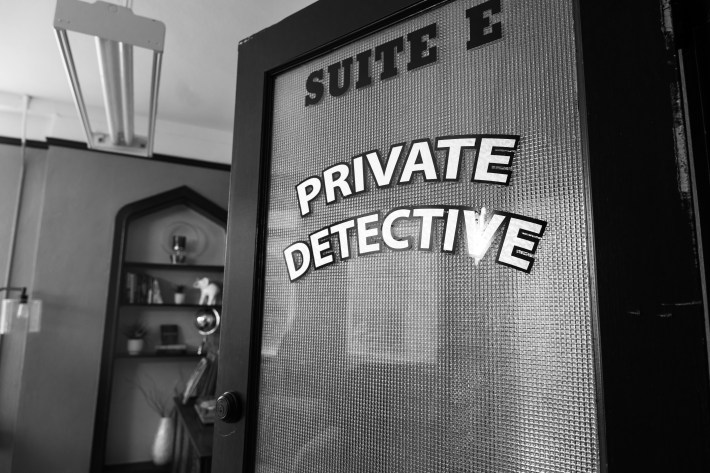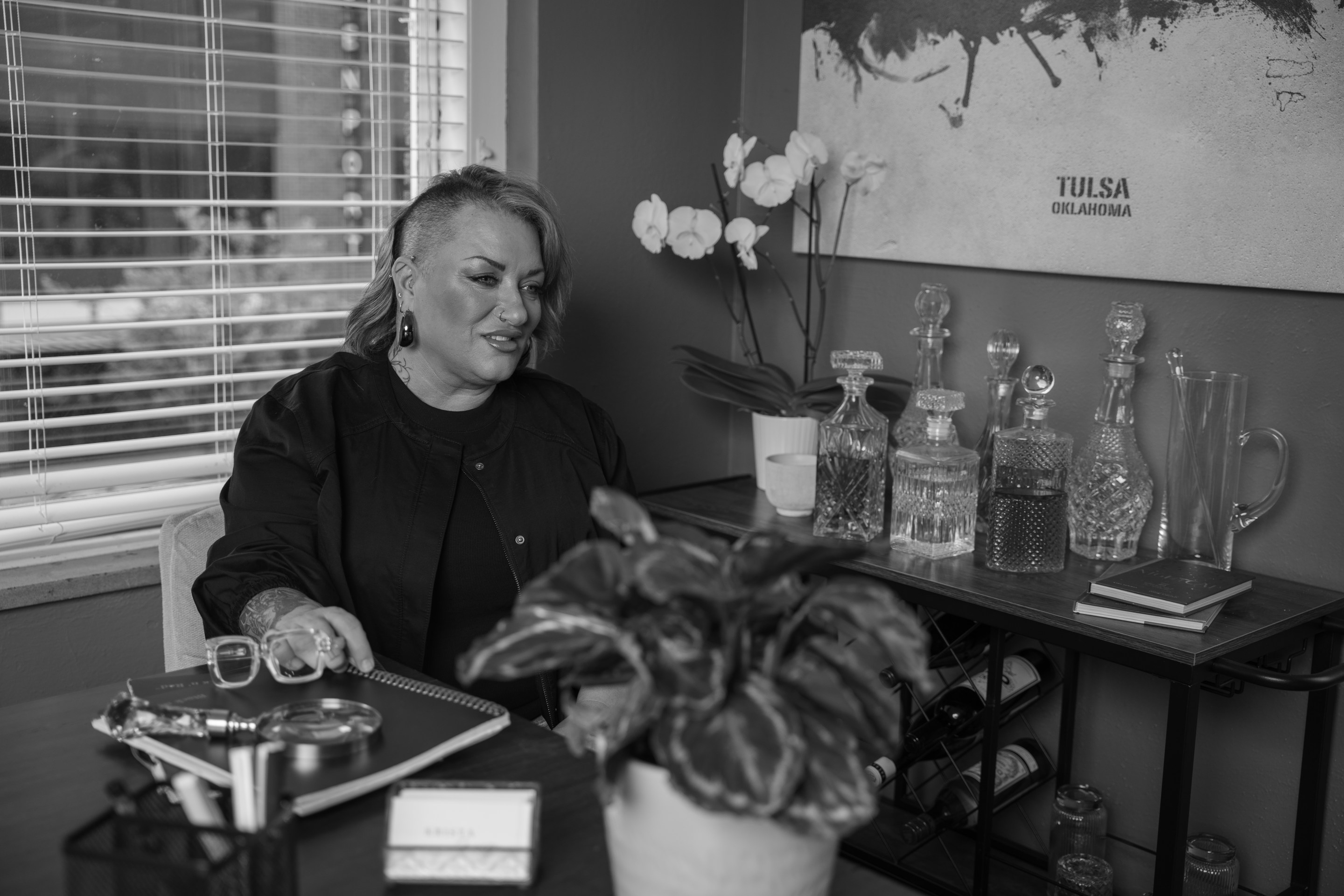Krista Pavey has a black eye.
The bruise peeks out from beneath a careful layer of makeup applied as a disguise, framed by hoops in Pavey’s ears and a nose ring. Is it from a surveillance job gone wrong, an unfaithful husband catching a glint of a camera lens from across a seedy motel parking lot at 4:00am? Or did a client-turned-stalker, on the prowl for months, finally carry out threats conveyed in hundreds of maniacal texts? No. Pavey, AKA SpyGirl, 53, is armed—learning to carry a weapon was part of the private detective training she completed 13 years ago—but the shiner is unrelated to her job. It’s from botox.
A girl’s got to keep up appearances.
It’s a typical day, calls and emails from home through the morning, then downtown at lunchtime to an office near Cain’s Ballroom, and if you want to know exactly where you can sleuth that out for yourself, pal. By design, the office has a noir vibe: a couple of codes to get into a cavernous foyer, precipitous stairs up to another code door, then a dusky hallway to a room with walls on the brown side of maroon, two candles flickering, a couch, and a desk with a magnifying glass laid out as decoration, but no Meerschaum pipe. There are framed quotes—“Well-behaved Women Rarely Make History,” “Nevertheless, She Persisted”— and shelved books: The Art of War for Women, The Gift of Fear, Fight Like a Girl and Win. For creature comforts, the room has a small flat screen TV, a coffee maker, a microwave and minifridge, and, portentously in a corner, several crystal flasks filled with amber liquors that Pavey is happy to offer to casual visitors, along with a ball of sphere ice.
Her work fills 53 Black & Red notebooks, but only a few lay open on the desk for the day’s efforts, glowing under an old-timey Edison bulb.
All morning she’s been getting texts from an actor on a popular Netflix show whose likeness has been stolen for a catfishing scheme. A 76-year-old woman believes she’s in a relationship with the man—she’s not—and now the actor, the real actor, is trying to set things right. Only a small portion of Pavey’s business these days is uncovering these schemes, but it’s enough that she’s developed a script for how to break the news.
For these cases, Pavey charges less than her usual rate, with a surcharge if it’s dangerous, even though it’s sometimes hard to tell if you’re solving a catfish case or are a part of one. Once, Pavey found the likeness of a catfisher in a random Swedish catalog. Most victims get suspicious after they’ve been bilked out of around $20,000, but sometimes it’s more. One guy lost his home and his business, and was living out of his truck until his catfisher convinced him to sell that, too.
“I guess I don’t care if it’s a scammer,” one forlorn victim told Pavey, after she broke the news.
That’s just the first of the day’s cases.
There are two cases of people violating the no-cohabitation clause of their divorce agreements. One woman is so good at hiding the men she wants to live with that Pavey is contemplating a dreaded “trash pull”—rubbish is fair game once it’s at the curb.
Another case is criminal background work; generally speaking, half of Pavey’s work is private clients, the other half is contracted work for defense attorneys. A Tulsa man defending his elderly parents shot three home intruders, killing all three. Pavey is investigating the intruders’ gang connections.
Another criminal case involves a young man who wandered off on a steamy night, after drinking. Another man picked him up, and five days later he was found dead. The weird part was that police had already searched that area. No one could explain why it had taken so long to find the body…
On the private side of things, Pavey has two pending infidelity cases. In one, a man had supplied a pair of his wife’s panties and a cotton swab smeared with a dollop of his fluids—was there more than a single set of DNA lurking in the silky folds of his wife’s soiled underthings? In the other, a woman had paid handsomely to investigate her husband only to relent after reflection—if she didn’t trust him, she shouldn’t have married him, she said. Pavey could keep the retainer.
The day’s most interesting case is a man whose ex-wife is now living with a violent, wanted criminal. A child is involved; the criminal is suspected of abuse. Pavey’s found the couple and the boy, and has arranged with law enforcement to pick up the wanted man, later today. But they have to time it right—if they move at the wrong moment, there’s no telling how long it will take to find them again.
All in all, it’s shaping up to be a normal afternoon in Tulsa’s coolest second act career.

Storage wars
The data will surprise you: decades after Cybil Shepherd paid her taxi driver’s fare and founded a female-run detective service in Moonlighting—at least until Bruce Willis died hard—the gender disparity among detectives and investigators has at last begun to approach parity. As of 2022, women accounted for 47.7% of all individuals employed nationwide as private detectives and investigators, and since 2014 the industry as a whole has grown at a 27% annual clip.
But not so fast. The devil is in the data, Pavey warns. There’s a big difference between a detective and an investigator, and much of the growth appeared to be in big coastal cities. Women make excellent investigators, sure, but Pavey is aware of only about a hundred Oklahoma women licensed as private detectives—a fraction of them are working, even fewer have their own agencies.
That said, the critical skill to being either an investigator or a private dick—ahem—is research, and what Pavey tends to think when people ask her how to become a detective is that they probably wouldn’t be very good at it: Look it up yourself, Slick.
Truth be told, becoming a detective may not have been Pavey’s idea, entirely.
She had a normal Tulsa childhood. Lots of memories of lake life, theatre and debate in school, and work in community plays in the years to come cemented her love of her hometown. Lasted about a year in a Dallas film school—learned she was a stage girl—and came home to take a few business courses at Tulsa Community College, get married to great guy and have a couple of great kids, and do all kinds of things to pay bills: teach preschool, wait tables, and sell Mary Kay, long enough that she very nearly reached the level that would have entitled her to a pink Cadillac XT5.
There was other life stuff back there—shit happens kind of life stuff—and no, she’s not going to talk about it.
But what is relevant, very relevant, are the years she spent running one of her father’s businesses, a storage facility. The place was shot through with crime—meth labs on site, people storing stolen property. If you could imagine it happening in a unit, it was happening.
Turned out Pavey was good at management: she raised occupancy from 76% to more than 90%, and added space. She loved the clients, but not the crime. Made an important decision in there, more important than she could have anticipated at the time. Started putting new customers on notice: she was the sheriff of this town. Began compiling entry/exit logs and watching suspicious units, gathering video evidence, and putting together files for law enforcement. Before long people were getting arrested right and left, and even the cops wondered where she’d gone to school to learn how to create such detailed case reports. Friends wondered: had she ever thought of becoming a private detective?
A light bulb—Edison-style—switched on.
It felt like time for a change. Her father had just passed away; her son was just graduating high school; her daughter was in junior high. Maybe this was fate calling. Researching how to become a detective took all of thirty seconds. Within thirty minutes, she had a whole plan written out. There were four classes offered by the Council on Law Enforcement & Training (CLEET) that gave you the basics, and then a course offered by a working PI to learn about the actual industry.
She joined the Oklahoma Private Investigators Association (OPIA)—Pavey now serves as one of its officers; the organization holds monthly meetings at Tulsa restaurants—and that put her in the path of a series of invaluable mentors: Linda Jones, the first female PI in Oklahoma and the first and only female president of OPIA; Chris Slaton of Midnight Run Services in Tulsa, current president of OPIA; Marvin Baker of War Eagle Services in Sperry, still working murder cases even though he’s close to 80; and Bob Powell of Eye Q Investigations, a former Air Force Office of Special Investigation and Oklahoma State Bureau of Investigation agent with a particular interest in cold cases. After all the training, Pavey rented a space and called on her TCC marketing training to get things moving.
It was 2012. Tulsa Private Investigation: Home of SpyGirl was up and running within six months. Today, Pavey is the premier female private detective in Tulsa, and with, at times, dozens of cases running at once she might be the busiest PI in Oklahoma.

The case of the missing cookies
Her first case—no shit—was a cookie thief.
A whole bunch of cookies were going missing at a local cookie factory, and she got the call because someone had heard about the success she’d had in rooting out theft at the storage place. It wasn’t exactly what she’d thought being a private detective would be like—who knew there was a black market for Milanos?—but it was a perfect fit: Pavey re-aimed their security cameras to cover the exits and added a sign-in/sign-out sheet for everyone coming onto the property. The culprit—not a mouse, but a driver—was apprehended in short order.
Not long after, and maybe this was the real beginning of her career, she got a call that haunts her to this day.
Someone was missing. That particular case remains unsolved, so Pavey won’t say much about it, but she does say two things: first, like with the cookie factory, she’d had no idea that in becoming a detective she would be called upon to find missing persons. Second, that call triggered a cascade of memories.
Pavey’s sister, six years older, went missing for a year when Pavey was about 11. She’d met some guy, then just didn’t come home one day. At first, they thought she was with friends; it took several days for the police to get involved. Days became weeks, weeks became months. Dad was tenacious and Pavey knew he was looking for his daughter, somehow. Mom refused to leave home in case the landline rang—no cell phones back then, and no internet either. Neither one of them wanted to talk about it. It was a lot for an 11-year-old, and sometimes Pavey snuck into her sister’s room just to crawl into her sleeping bag.
The sister turned up, but it wasn’t a happy ending: she was in a hospital, beaten all to hell, and eight months pregnant.
Bottom line, when Pavey got that first call for a locate job, she was surprised but totally right for it, because she knows what it’s like when a family member vanishes. That’s when she knew she could make a difference in the world of the missing.
Counterintuitively, it’s not that common for detectives to work missing cases—the sad reality is that it tends to be poor people who disappear, people who can’t pay—but the ones Pavey went on to investigate, hundreds of them at this point, taught her multitudes about criminal investigation, documentation, the importance of timelines. Most of Pavey’s cases are paid—as a rule, the criminal defense work pays better than the private stuff—but she always has a handful of pro bono cases of individuals who have just up and disappeared. When people go missing, the crazies appear—Pavey has stories of wacky clients, scary clients—but the calls keep coming because the news is out: she knows how to hunt people down.
In the beginning, Pavey admits, she had a bit of impostor syndrome: could she really just become a detective, without formal training or experience in this or that aspect of the job? Perhaps there was some luck there. She jumped onto Facebook just as people were beginning to make business pages, and now she has 10,000 followers, offers classes, does some mentoring work, and every couple of months participates in an online Q&A for people curious about the profession.
There was so much to say, so many details to learn, so many pitfalls to avoid. She loves the work, loves relying on her gut to get to the truth. The variety itself is part of the appeal, from comic cases like cookie thieves to deeply meaningful work like coordination with search and rescue groups and assignments from the Oklahoma Innocence Project.
It all boiled down to one thing: being a PI is not a job, but a craft.

The craft
There are exciting days in the life of a private detective, days when Pavey’s out doing surveillance in the wee hours—one day, she had to scramble and improvise to cover two houses at once—but most days, the days that typify the profession, are like this one: long hours at the office, lots of notes, lots of research. Sometimes Pavey can keep the workday to eight hours, and sometimes the days run to dusk and beyond and she doesn’t even notice.
Out in the hallway, a phone rings and there are footsteps. The silhouette of a person appears in the frosted window of Pavey’s office door. For an instant, it feels like a Bogart film: the dame, the femme fatale, is about to make her entrance.
The silhouette moves off, taking a call. It doesn’t matter, because the dame is already on stage, behind her desk, flipping through her Black & Red notebooks.
Patience is key; progress is slow. Within a week, Pavey will have made incremental progress on all of the cases she’s now handling. The panties-and-swab have been sent to the lab; results can take forever. The trash pull got tricky because two different trash companies serve the area, and she’s learned the hard way that they don’t pick up on the same day. Pavey’s submitted a FOIA request for the dead girl because she needed to see pictures of the scene; another possible boondoggle. The catfish victim now understands that she’s not in a relationship with a famous actor, but she can’t quite quit whoever has been sending her messages. The violent criminal, possibly abusing a boy, turns out not to have an active warrant after all—he might have been put into some kind of program, and now he’s coaching the boy’s Little League team. It looks like Pavey will be attending some games.
For now, though, SpyGirl sits in her office. The job is research, notes, timelines—hard work, all. There’s half a million stories in the Magic City, and if you know where to look, you can touch them all.







